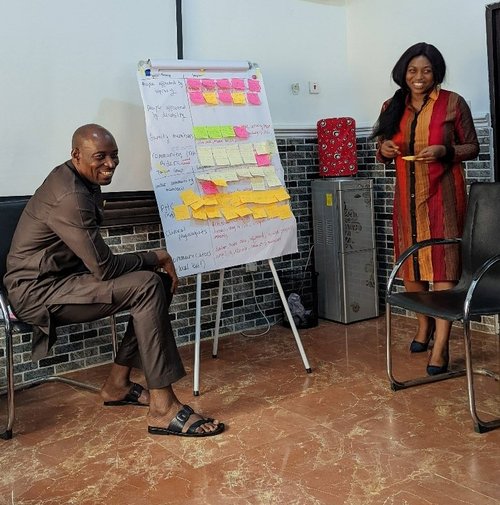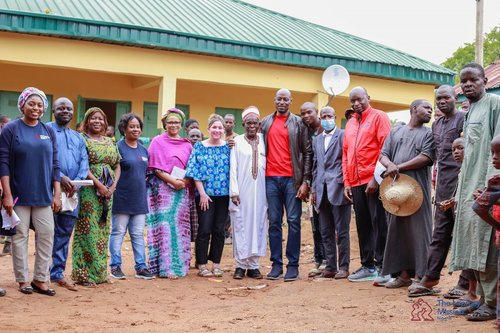Human Centred Design: creating solutions for people affected by leprosy
Laura Tenney, Institutional Funding Officer reports on an exciting visit to Nigeria and gives an insight into how our projects are designed to have the greatest possible impact for people affected by leprosy
Have you ever wondered how The Leprosy Mission creates new projects? Where do the ideas come from and how do we make sure they make a real difference in the lives of people affected by leprosy? Recently, along with two colleagues, I had the privilege of visiting Nigeria to help design two new projects.
Working together with The Leprosy Mission Nigeria staff, medical professionals, people affected by leprosy and other partners, we used a process called the Theory of Change. Simply, this means we reflect on our aims and plans, discuss them with others and make them clear. Throughout the process we plan how we will move from an identified problem to the goal - the change we want to see for people affected by leprosy - and all the steps in between that will create long-lasting change.
Unique challenges; unique solutions
As The Leprosy Mission England & Wales we support more than 50 projects across ten countries. Most of these projects run for three years, then a new project expanding on what has been achieved begins. Each project is unique and individually designed to address specific challenges that people affected by leprosy face in that country and context, because the countries we work in are very different. For example, an elderly woman with disabilities in India will face very different challenges to a young boy with parents affected by leprosy in Nigeria.
For this reason, we must understand the unique challenges people face and tailor each project to address these problems, using innovative ideas to create meaningful change in the communities we serve.
It sounds quite straightforward but in reality, these conversations are complex, requiring detailed thinking and problem solving. In Nigeria, we used creative ways to think about solutions using lots of brightly coloured post-its, spider diagrams, flow charts and presentations. It was a great exercise enabling us to dream big and build relationships as a team.

For a while now our colleagues in Nigeria have been troubled by the high rates of depression and anxiety among people affected by leprosy and their family members. They are also trying to improve the care available for leprosy and other skin conditions, especially in rural areas where there are very few health facilities and health workers.
We set out to explore these two problems and develop projects to address them, spending a week problem solving, brainstorming and listening to our colleagues. Most importantly we heard from people affected by leprosy about the challenges they face and the consequences that leprosy can have on their families, livelihood opportunities and inner wellbeing.
Centring the voices of people affected by leprosy
This human-centred approach to project design is crucial to understanding the unique perspectives of people affected by leprosy and ensuring that they remain at the heart of everything we do. Throughout the process, it is also important to recognize how gender and disability will contribute to how people face similar challenges. They will each have a unique understanding and story to tell.
There was much to uncover about the real challenges Nigeria faces. We were surprised to learn that in the entire northwest of Nigeria, an area with a population of at least 30 million people, there are only three dermatologists. This means access to accurate quality diagnosis and treatment is very difficult.
We also discovered that the current laws that guide the practice of mental health care in Nigeria date from the 19th century: people with mental health illnesses can be incarcerated with very few rights. It's heart-breaking to see the lack of recognition around mental health problems in Nigeria, especially as we know that being diagnosed with leprosy and the consequences of it can be mentally exhausting.

After speaking to some of the staff and partners who will be involved in these future projects, we visited a leprosy community to hear directly from its residents. We spoke to men, women and young people, conducting focus groups and asking a variety of questions. Our goal was that every person would have the opportunity to speak openly about their challenges and also what they enjoy about living in the leprosy community.
People expressed how peaceful and safe they felt and how the community was a haven, free from stigma and discrimination. They showed immense gratitude and thankfulness for The Leprosy Mission‘s support and it was a real pleasure to be welcomed into their community. At one point, a young mum let me hold her tiny baby and as I held him in my arms, I pondered what their future might look like. It was a reality check that through this project design process, we are creating real opportunities for people affected by leprosy today and for future generations.
The whole trip was a fantastic opportunity to build relationships, dream about the future and create new projects which will bring transformation to people's lives. It was a huge blessing, and we pray for this fruitfulness to continue as these new projects start next year.
It’s thanks to the dedication of supporters that they will make an enormous difference in people’s lives. Thank you for being part of the chain reaction that connects supporters, staff and people affected by leprosy to change lives around the world.